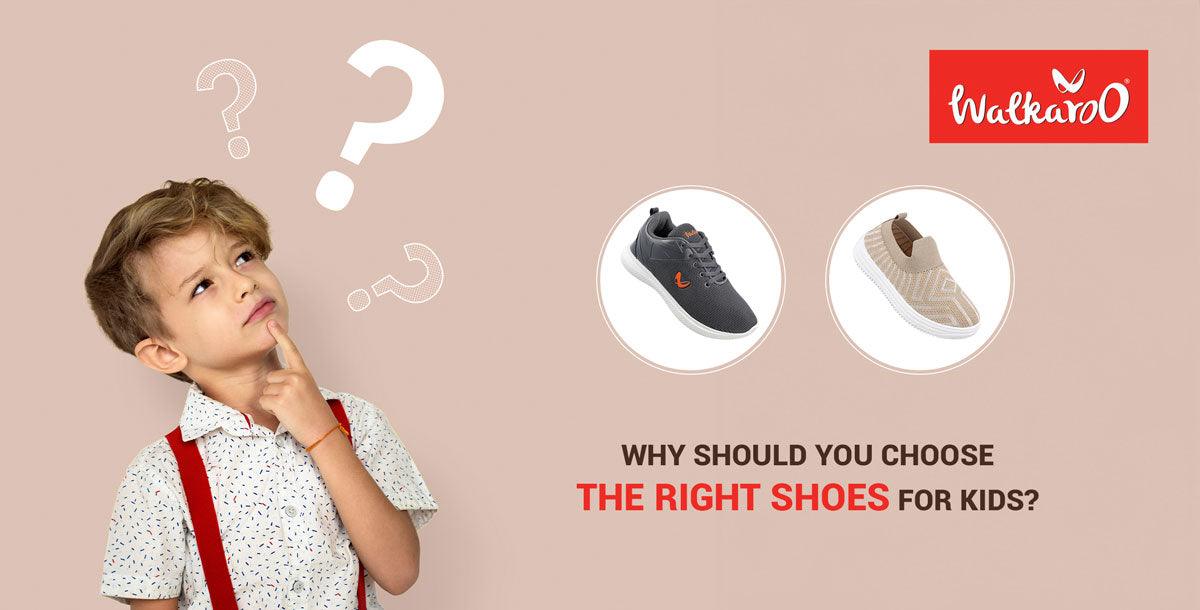Kids outgrow shoes fast, and it may seem smart to reuse older siblings' shoes. But hold on-shoes adapt to the shape of a child's foot and gait. Reusing worn shoes may impact posture and even lead to long-term foot issues.
Shoes for kids appear to be a poor investment because they outgrow them so quickly. Most parents try to wear the shoes they bought for the older child on the younger one. But be wary, parents: even if the shoes look in decent shape, they may have structural modifications you are unaware of.
You may wonder if, despite certain fundamental modifications, it is still new and reusable. However, an individual begins to establish their gait around the age of three; if they are forced to wear ill-fitted shoes, it may interfere with their natural stride and, in the worst-case scenario, cause lasting deformities.
Role of Kids Shoes in Supporting Healthy Foot Development
Even though walking barefoot is considered to be good for the development of kids' feet. It is necessary to emphasize the impact of wearing the right fitted shoes on the overall growth and well-being of the kids. Since their foot bones and muscles are still growing, they might not have a good balance over their body, so wearing shoes can prevent injuries.
Properly fitted kids shoes can give support and stability, allowing children to develop better body posture as they grow. Furthermore, wearing the proper fit can encourage children to participate in various activities, allowing them to live an active lifestyle.
Thus, it is apparent that investing in children's shoes today is an investment in their future health and development. So, let's support our budding stars to have a long and happy life.
Common Problems in Kids from Wearing the Wrong Shoes
There are two types of ill-fitted shoes for kids: too small or too big. The too-small shoes will be too tight for your young ones' feet, causing blisters, bunions, ingrown toenails, and calluses.
Conversely, large shoes lead the child's feet to slip and slide while walking. This raises their risk of slipping and falling. Many toddlers suffer from hammertoes, which develop when they wear larger shoes and constantly curl their toes. Over time, your child's middle joints will bend, resulting in abnormal arches, which would necessitate surgical procedures for correction.
Key Features to Look For Kids Shoes
What comes to your mind when you imagine shoes for kids?- Something that is light, flexible, crafted from comforting fabric, and has a good build for support- right?
Let's discuss the features to consider when picking out shoes for your kids,
1. Comfort and Fit
When choosing shoes for children, prioritize comfort and practicality. Ill-fitted shoes can cause discomfort and foot problems, discouraging children from wearing shoes in the future. Parents must ensure shoes fit properly and have quality cushioning before purchasing.
Boys Shoes must have plenty of area for the toes; otherwise, feet would enlarge while sweating, leaving little wiggle room for your child's feet, which might cause blisters, rashes, and other foot issues.
2. Support and Stability
Children are always curious to learn new things. Thus, they require shoes that can support them in their endeavors. Hence, kids' shoes are designed to provide superior arch support, which helps safeguard their ankles while they play.
Flip-flops, high heels, and other footwear provide little ankle support, making it difficult for children to walk while wearing them. So, among kids footwear, shoes are the safest choice for your kids.
Always choose non-skid or soleless shoes for your kids, as they will tightly grip the floor, providing better stability to your child while walking on slippery surfaces.
3. Material
When purchasing shoes for kids, always look for breathable materials like mesh, canvas, or leather. Kids' feet sweat comparatively more than adults, therefore shoes with breathable material can help in air circulation, preventing the growth of bacteria or fungi.
4. Flexibility
Children cannot sit still for a second; they move constantly, so children's shoes must be flexible to allow for free and comfortable movement. Shoes for girls with a flexible front and a rigid rear are typically recommended because they provide enough foot support.
Flexible shoes are easy to bend, this will allow your children to move without any restriction. They can engage in any activity.
Why Are Properly Fitted Shoes Important for Kids?
Proper shoes:
-
Support natural movement
-
Improve balance and posture
-
Prevent slips, injuries, and foot strain
-
They help your child feel confident and stay active.
What Happens If Kids Wear the Wrong Shoes?
Too Small:
-
Blisters
-
Ingrown toenails
-
Bunions
-
Calluses
Too Big:
-
Slips and falls
-
Hammertoes
-
Abnormal arches
Can Wearing Big Shoes Be Harmful for Kids?
Yes. Shoes that are too large make the child curl their toes for grip. This unnatural movement can lead to joint deformities and may eventually require surgical correction.
What Kind of Shoes Should Children Wear Daily?
-
Comfortable FitChoose shoes with enough room for toes and proper cushioning.
-
Supportive SolesLook for shoes with arch support and non-skid soles for safety.
-
Breathable MaterialsMesh, canvas, and leather prevent sweat buildup and infections.
-
Flexible DesignLet kids move freely-go for shoes that bend easily in front but are firm at the back.
How Often Should I Replace My Kid's Shoes?
Kids grow fast-aim to replace shoes every 4 to 6 months or 2-3 times a year. Don't size up too much to save money-it may harm their posture and walking pattern.
When to Replace Kids' Shoes?
Children outgrow their shoes eventually because they grow faster than adults. Therefore, as your children grow, you should plan to replace their shoes two or three times a year. Some parents purchase shoes a few sizes larger to avoid this, but this can hurt our children's natural posture and stride. For optimal foot growth and development, strive to replace your kid's shoes on time.
FAQs
1. Why are good shoes important for kids?
Good shoes will help in the proper growth and development of your kid's feet. Shoes can provide support and stability to your kid while walking, this will improve their gait and overall body posture.
2. Are light-up shoes safe for kids?
Light-up shoes contain batteries; while the batteries are not powerful enough to electrocute children, minor sparks caused by the fraying wires can cause fires. Many examples have been documented in which youngster's sustained burns as a result of chemical leaks from light-up shoe batteries. Light-up shoes are popular among children, however they are not suitable for their safety.
3. Why is the selection of the right shoes important?
Selecting the right shoes for kids can prevent injuries, enhance their natural gait, and provide support to their ankle while doing different activities. This will encourage kids to actively seek out as many activities as possible.
4. What is the advice for children's shoes?
When purchasing shoes for your children, always check for the fit and size of the shoes. Look for shoes with proper arch support, quality cushioning, non-skid soles and replace them every 2 to 3 times in a year.
5. What shoes should children wear?
For infants shoes are merely decorative but once they start walking make sure to buy non- sole shoes, these are lightweight and can safeguard against injuries. For children in elementary school you can invest in sports shoes with non-skid soles. These shoes are comfortable and their non-skid feature gives them extra grip and balance to continue their routine activities.
6. What are the best shoes for toddlers learning to walk?
Lightweight, flexible, and non-skid shoes that mimic barefoot movement are ideal for new walkers.
7. How do I know if my kid's shoes are too tight?
Check if their toes touch the front or if they complain about pain after walking. Red marks and blisters are also signs.
8. Are light-up shoes safe for kids?
They may contain small batteries that could leak or spark. Avoid them if safety is a concern.
9. What shoes are best for active kids?
Sport shoes with cushioned soles, breathable fabric, and good grip help kids play safely and comfortably.
10. Can shoes affect my child's walking posture?
Yes. Poorly fitted shoes change how they walk and may lead to long-term postural issues.


Share:
The Best Formal Shoes for Men on Every Budget
Tips to Replace Heels with Stylish and Supportive Sandals